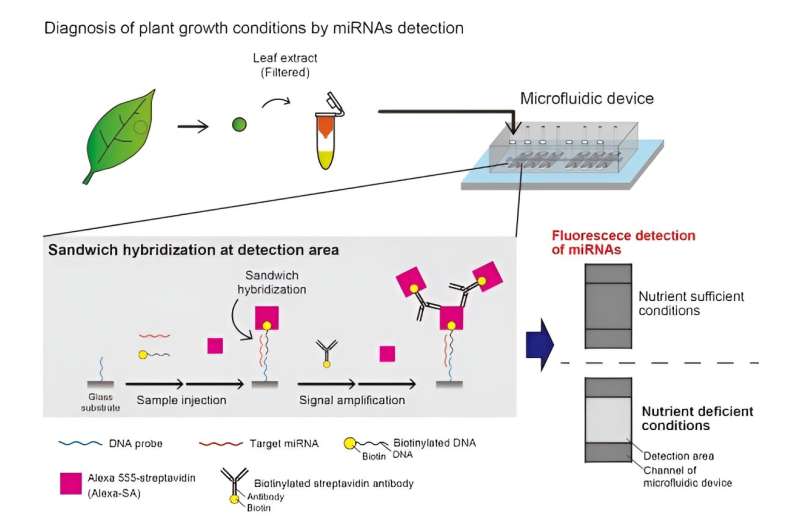This article has been reviewed according to Science X's editorial process and policies. Editors have highlighted the following attributes while ensuring the content's credibility:
fact-checked
trusted source
proofread
Improving plant health diagnostics: The dawn of microfluidic devices for rapid miRNA detection

In natural environments, plants encounter biotic and abiotic stresses that can significantly affect their productivity and health. Recognizing the importance of timely stress diagnosis, researchers have developed various sensors and devices to detect plant hormones, heavy metal responses, and pathogen invasions.
Current research is focused on miR399, a microRNA that is critical for phosphate homeostasis in plants, which could serve as a general biomarker for detecting phosphorus starvation. Despite the availability of various miRNA detection methods such as northern blotting, microarray, and real-time PCR, these methods are often time-consuming and complex. The development of microfluidic technology for point-of-care (POC) applications shows promise for rapid, simple, and sensitive miRNA detection, potentially revolutionizing plant stress diagnosis and management.
However, there are still challenges in adapting these technologies for widespread agricultural use, highlighting the need for further research to make these diagnostic tools more accessible and effective for precision farming.
In March 2024, Plant Phenomics published a research article titled "Microfluidic device for simple diagnosis of plant growth condition by detecting miRNAs from filtered plant extracts."
To tackle the issue of identifying microRNAs (miRNAs) in plants, a novel microfluidic device system has been developed. The system focuses on detecting miR399, which is a biomarker for phosphorus deficiency stress. The device employed micro-flow channels to immobilize DNA on glass surfaces, facilitating the creation of DNA-probed areas for miRNA detection through sandwich hybridization.
The method detected artificially synthesized miR399c, demonstrating the device's high specificity in identifying miRNA presence, even at low concentrations. Further experiments validated the device's effectiveness in detecting miR399c within tomato leaf extracts. Enhancements were made through the use of RNase inhibitors, DTT buffers, and size-fraction filtration to improve detection sensitivity.
Subsequent studies expanded the device's application to detect endogenous miRNAs in tomatoes, revealing an increase in sly-miR399 expression under phosphorus-deficient conditions. The study demonstrated the device's potential for rapid and accurate stress diagnosis in agricultural settings, highlighting its ease of use and the possibility for early intervention in crop management.
The microfluidic device's capacity to diagnose phosphorus deficiency stress in tomatoes by detecting sly-miR399 expression was further demonstrated in cultivation experiments. These experiments showed that the device could effectively identify phosphorus deficiency, enabling timely adjustments in nutrient provision to prevent growth failure.
In conclusion, the development and application of this microfluidic device represent a significant advancement in the field of plant phenomics. It offers a practical tool for the early diagnosis of nutrient deficiency stress. The device's simplicity, accuracy, and potential for point-of-care diagnostics underscore its value in enhancing sustainable agriculture and precision farming, by facilitating early intervention and informed cultivation management decisions.
More information: Yaichi Kawakatsu et al, Microfluidic device for simple diagnosis of plant growth condition by detecting miRNAs from filtered plant extracts, Plant Phenomics (2024). DOI: 10.34133/plantphenomics.0162
Provided by NanJing Agricultural University





















